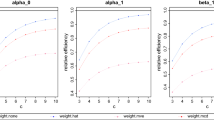Abstract
In this paper, we consider robust M-estimation of time series models with both symmetric and asymmetric forms of heteroscedasticity related to the GARCH and GJR models. The class of estimators includes least absolute deviation (LAD), Huber’s, Cauchy and B-estimator as well as the well-known quasi maximum likelihood estimator (QMLE). Extensive simulations are used to check the relative performance of these estimators in both models and the weighted resampling methods are used to approximate the sampling distribution of M-estimators. Our study indicates that there are estimators that can perform better than QMLE and even outperform robust estimator such as LAD when the error distribution is heavy-tailed. These estimators are also applied to real data sets.
Similar content being viewed by others
References
Berkes, I., Horváth, L.: The efficiency of the estimators of the parameters in GARCH processes. Ann. Stat. 32, 633–655 (2004)
Bollerslev, T.: Generalised autoregressive conditional heteroscedasticity. J. Econ. 31, 307–327 (1986)
Chatterjee, S., Bose, A.: Generalized bootstrap for estimating equations. Ann. Stat. 33, 414–436 (2005)
Christoffersen, P.: Evaluating interval forecasts. Int. Econ. Rev. 39, 841–862 (1998)
Engle, R.F.: Autoregressive conditional heteroscedasticity with estimates of the variance of UK inflation. Econometrica 50, 987–1008 (1982)
Engle, R.F., Ng, V.: Measuring and testing the impact of news on volatility. J. Finance 48, 1749–1778 (1993)
Glosten, L., Jagannathan, R., Runkle, D.: On the relation between the expected value and the volatility on the nominal excess returns on stocks. J. Finance 48, 1779–1801 (1993)
Huber, P.J.: Robust estimation of a location parameter. Ann. Math. Stat. 35, 73–101 (1964)
Iqbal: Contribution to M-estimation of conditional heteroscedastic models. PhD Thesis, Department of Mathematics and Statistics, Lancaster University, UK (2009)
Kupiec, P.H.: Techniques for verifying the accuracy of risk measurement models. J. Deriv. 3, 73–84 (1995)
Mukherjee, K.: M-estimation in GARCH model. Econ. Theory 24, 1530–1553 (2008)
Nelson, D.B.: Conditional heteroskedasticity in assest returns: a new approach. Econometrica 59, 347–370 (1991)
Peng, L., Yao, Q.: Least absolute deviations estimation for ARCH and GARCH models. Biometrika 90, 967–975 (2003)
Robinson, P., Zaffaroni, P.: Pseudo-maximum-likelihood estimation of ARCH(∞) models. Ann. Stat. 34, 1049–1074 (2006)
Taylor, S.: Modelling Financial Time Series. World Scientific, Singapore (2008)
Tsay, R.S.: Analysis of Financial Time Series. Wiley, New York (2005)
Zakoian, J.M.: Threshold heteroskedastic models. J. Econ. Dyn. Control 18, 931–955 (1990)
Author information
Authors and Affiliations
Corresponding author
Rights and permissions
About this article
Cite this article
Iqbal, F., Mukherjee, K. M-estimators of some GARCH-type models; computation and application. Stat Comput 20, 435–445 (2010). https://doi.org/10.1007/s11222-009-9135-x
Received:
Accepted:
Published:
Issue Date:
DOI: https://doi.org/10.1007/s11222-009-9135-x



